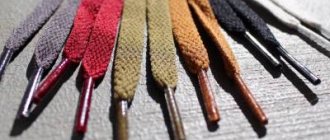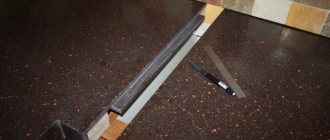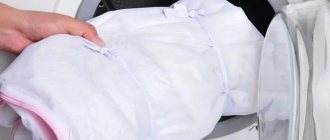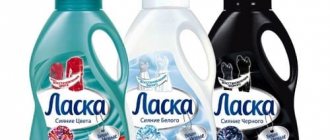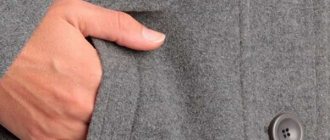Home page » Home and comfort » Washing
Author of the article
Svetlana Pavlikhina
Reading time: 4 minutes
AA
To ensure that no part of the curtains is damaged, first learn how to wash curtains and what products to use.
The presence of accessories complicates the process and can lead to damage to the fabric. Fasteners require delicate handling.
Quality of eyelets and washing
It is worth considering the material of the grommet, otherwise you can ruin the entire curtain:
Tree. The material is afraid of water. After washing, the item will swell, become wet, and will not be able to return to its previous state. If there is paint on the grommet, it will peel off. Hand wash or dry cleaning recommended.- Metal. If moisture acts on an object for a long time, rust appears. When purchasing, it is recommended to use stainless material, then there will be no contraindications for machine washing. Use non-aggressive detergents that preserve the quality of the part.
- Plastic. The material does not deteriorate when exposed to water. Wash by hand or machine. But if the parts are made of cheap plastic, cracks may appear.
You need to find out about the material used to make the eyelets not before washing, but when you buy the curtains.
When not to wet clean
Wet cleaning is not recommended if the curtains are velvet or linen.
It is forbidden to wet curtains if they have rusting metal parts or wooden fittings. This leads to damage to the entire canvas.
Important points
If a person is preparing to buy curtains or wants to clean them, it is worth finding out what they are made of.
There are certain washing modes for different types of fabrics and materials. They are taken into account so as not to spoil the curtains.
Machine washable
With this method, it is recommended to choose a temperature range of +40…+60 °C. This will prevent the fabric from shrinking, fading, and damage to the fibers.
This type of washing is allowed for the following fabrics:
cotton, tulle (no more than +40 °C);- polyester (up to +60 °C);
- taffeta (+50 °C).
Higher temperatures are prohibited: the fabric will shrink and the design will deteriorate.
Delicate mode
Special attention is paid to fabrics that require delicate treatment.
They can also be machine washed, but when changing temperature conditions, speed, spin:
- muslin;
- acrylic;
- veil;
- viscose.
It is best to place the linens in a special case for washing and only then load them into the drum.
The water temperature should not be higher than +30 °C. It can also be washed in cold water if the owner is concerned about shrinkage.
Rinsing is performed at minimum speed, since the fabrics have a thin structure, holes and puffs quickly appear on them.
Hand wash
It is not advisable to use the machine for flock, linen and velvet. Linen shrinks greatly and cannot be smoothed out. Velvet changes its structure, becomes stiff, and the pile lies in different directions.
Therefore, choose 2 options:
- wash or lightly rinse by hand;
- dry cleaning
If the owner of the curtains is allergic, it is better to clean it yourself using a powder that will not cause a negative reaction in the body.
How to hang curtains: ties
The curtain with ties is simply tied to the curtain rod with a knot or bow. The ties can be made of the same material as the curtains and sewn to them, or they can be selected separately and threaded through the holes.
Style.
Fabric strips or ribbons tied in a bow will look best on weightless curtains for a bedroom or nursery, or on linen kitchen curtains. They add romanticism and playful lightness, and therefore the best styles for curtains with ties: Provence, shabby chic, country and vintage. If you choose a rough natural lace and tie it in a knot, it will be an interesting solution for eco and rustic styles.
Pros.
Additional decoration; noiselessness; can be attached without removing the cornice.
Minuses.
It is difficult to move along the cornice; difficult to distribute into symmetrical distances for even folds of curtains; hang for a long time - tie each rope by hand; not suitable for heavy curtains.
Loops, like ties, are made from strips of fabric. However, the loops are usually wider than the ties (5-20 cm) and are sewn to the curtain at both ends; there is no need to tie anything. An alternative option is to have a Velcro, button or snap fastener.
Style.
The technique is universal and will suit both classic and modern styles, but mainly to “homey” and cozy interiors. For a solid living room or office, they are rustic. But in the Scandinavian style, this is the best choice.
Pros:
hang quickly; withstand heavy loads; silent; universal;
Minuses:
if there is no fastener on the hinges, you need to remove the curtain rod to hang the curtains; difficult to move along the cornice; difficult to distribute.
Metal or plastic rings are sewn into the top of the curtain. Using these rings, the curtain can be either strung on a curtain rod or hung with hooks, but the first method is more common and is not visually overloaded.
Style.
Eyelets are an ideal fastening for heavy curtains in the bedroom or living room. They are suitable for discreet, slightly heavy styles: strict classics, grunge, retro. They look good in lofts and minimalist interiors, since the fasteners themselves hardly stand out.
Pros:
quickly hang on the eaves; glides easily; allow you to easily distribute curtains along the cornice and provide symmetrical folds; wear-resistant; support a lot of weight.
Minuses:
moving noisily along the cornice; may scratch the cornice; you need to remove the rod to hang curtains; not suitable for light and thin curtains and tulles.
The rings are similar to eyelets, but located outside the curtain. The rings are strung on the cornice, and the curtain is already attached to them - it can be sewn, tied, hung on a hook or through grommets. The rings themselves can be plastic, metal or wood.
Style.
The material of the rings greatly influences the style: wooden rings are suitable for eco, rustic, country and strict classic styles; metal ones will fit into high-tech, loft and other modern styles. Rings are the right approach to straight curtains or canvases that you want to hang with rare large folds.
Pros:
withstand heavy curtains; universal; easy to move the curtain along the curtain rod; wear-resistant; easy to drape; not demanding on the shape of the cornice.
Minuses:
move noisily; difficult to remove; require an additional method of attaching the curtain to the ring.
You will find more ways in the continuation of the article.
Machine washing algorithm
It is recommended to estimate the size of the drum. Its minimum capacity must be at least 5 kg. This is designed for the most voluminous curtains, which add weight due to water filling.
The following steps are performed:
Curtains are placed in a drum or a mesh cover is used. The second option is preferable: it will prevent any damage.- Powder or other cleaning agent is poured into the desired compartment. To calculate the volume, you need to know the weight of the curtains. For every 5 kg of fabric use 2-3 tbsp. l. cleanser.
- Set the washing mode depending on the quality of the curtains. It can be standard, delicate. It is better to choose the number of revolutions yourself.
- As soon as the washing is completed, the curtains are immediately taken out so that they do not wrinkle. You can immediately hang them on the curtain rod or leave them on the dryer.
After complete drying, the curtains are ironed. If they straighten themselves, this is not required. But you can use a steam generator to remove any wrinkles.
How to calculate the number of eyelets on curtains?
Sketch of curtains with eyelets.
Since quite expensive fabrics for curtains are often used in interior design, the material should not be damaged due to a simple mistake or miscalculation. Therefore, before directly installing the linings, you should carefully calculate their number and location on the curtain fabric. In the future, this will not only ensure long-term and convenient operation of the curtains on the eyelets. Properly installed rings are also simply beautiful.
Meanwhile, the calculation process itself as a whole is not too complicated even for beginners in this matter. Nevertheless, knowledge of the special formula, certain, even minimal, skills and patience of the performer will be simply necessary.
First of all, you should understand a number of immutable rules and conditions that apply to this system. The very first rule is very strict: there must be an even number of eyelets on one curtain fabric. Otherwise, the edges of the canvas will be in different directions: one into the room, the other towards the window, which will look ugly. In this case, it is necessary to hang the curtains so that both edges of the canvas when hanging on the cornice are directed towards the window.
The minimum distance between the edge of the curtain and the center of the outer eyelet is allowed at 5-7 cm. If this value is less than the specified minimum, then when installing this lining there is a risk of getting on the folded edge of the canvas. With this option, the eyelet simply will not fasten.
Standard curtain pattern with eyelets.
At the same time, the minimum distance between the centers of the eyelets cannot be less than 15 cm, and the maximum should be 22 cm. If the distance is less than the minimum, it may be difficult to move the curtains along the cornice strip, and outwardly they will look overly stretched. Many experts consider the optimal distance between the centers of the eyelets to be 18 cm, but this rule is not strict, and if the size of the curtain does not allow you to adhere to the specified interval, you can choose another option.
To form attractive folds that distinguish curtains with grommets, the so-called drapery coefficient is used, which is 2-2.5. In practice, this means that the estimated width of the curtain (along the cornice), in order to ultimately obtain a beautiful drapery, must be multiplied by the specified coefficient. That is, if, for example, the cornice has a width of 3 m, then when hanging two curtains on it, you need to multiply half of this length (1.5 m) by 2. As a result, to make one of the two curtains you will need 1.5 x 2 = 3 m .
Manual method
Helpful Tips:
Prepare a bath or large basin. Pour water (+30 °C or lower). Add detergent (it is better to choose gel). It dissolves quickly in water. For this, 1 tbsp. l. diluted in 3 liters of water.- The curtains are placed in the liquid, soaking for 15-20 minutes. If there are eyelets, they are hung over the edge. If there are stainless steel elements, all parts are immersed in water
- Don't rub too hard. Use gentle movements to clean all sections of the curtain.
- You need to rinse the fabric at least 4 times in clean water so that all the soap solution is removed. This is evidenced by the absence of bubbles in the water.
Wring out the fabric, hang it on the dryer or directly on the curtain.
Proper drying
If the fabric is light and does not wrinkle much, hang it on a curtain rod. Using this method, cotton, acrylic, tulle, voile and other soft fabrics are dried.
If a person has thick curtains, for example, made of velvet, use a dryer. It must be large so that the entire canvas fits. It can be folded several times.
If the fabric is subject to stretching, it is not recommended to hang it on a curtain rod - this leads to an increase in size and distortion of the pattern. It is better to fold it and carefully hang it on the dryer.
How to hang curtains: ties
The curtain with ties is simply tied to the curtain rod with a knot or bow. The ties can be made of the same material as the curtains and sewn to them, or they can be selected separately and threaded through the holes.
Style.
Fabric strips or ribbons tied in a bow will look best on weightless curtains for a bedroom or nursery, or on linen kitchen curtains. They add romanticism and playful lightness, and therefore the best styles for curtains with ties: Provence, shabby chic, country and vintage. If you choose a rough natural lace and tie it in a knot, it will be an interesting solution for eco and rustic styles.
Pros.
Additional decoration; noiselessness; can be attached without removing the cornice.
Minuses.
It is difficult to move along the cornice; difficult to distribute into symmetrical distances for even folds of curtains; hang for a long time - tie each rope by hand; not suitable for heavy curtains.
Loops, like ties, are made from strips of fabric. However, the loops are usually wider than the ties (5-20 cm) and are sewn to the curtain at both ends; there is no need to tie anything. An alternative option is to have a Velcro, button or snap fastener.
Style.
The technique is universal and will suit both classic and modern styles, but mainly to “homey” and cozy interiors. For a solid living room or office, they are rustic. But in the Scandinavian style, this is the best choice.
Pros:
hang quickly; withstand heavy loads; silent; universal;
Minuses:
if there is no fastener on the hinges, you need to remove the curtain rod to hang the curtains; difficult to move along the cornice; difficult to distribute.
Metal or plastic rings are sewn into the top of the curtain. Using these rings, the curtain can be either strung on a curtain rod or hung with hooks, but the first method is more common and is not visually overloaded.
Style.
Eyelets are an ideal fastening for heavy curtains in the bedroom or living room. They are suitable for discreet, slightly heavy styles: strict classics, grunge, retro. They look good in lofts and minimalist interiors, since the fasteners themselves hardly stand out.
Pros:
quickly hang on the eaves; glides easily; allow you to easily distribute curtains along the cornice and provide symmetrical folds; wear-resistant; support a lot of weight.
Minuses:
moving noisily along the cornice; may scratch the cornice; you need to remove the rod to hang curtains; not suitable for light and thin curtains and tulles.
The rings are similar to eyelets, but located outside the curtain. The rings are strung on the cornice, and the curtain is already attached to them - it can be sewn, tied, hung on a hook or through grommets. The rings themselves can be plastic, metal or wood.
Style.
The material of the rings greatly influences the style: wooden rings are suitable for eco, rustic, country and strict classic styles; metal ones will fit into high-tech, loft and other modern styles. Rings are the right approach to straight curtains or canvases that you want to hang with rare large folds.
Pros:
withstand heavy curtains; universal; easy to move the curtain along the curtain rod; wear-resistant; easy to drape; not demanding on the shape of the cornice.
Minuses:
move noisily; difficult to remove; require an additional method of attaching the curtain to the ring.
You will find more ways in the continuation of the article.

